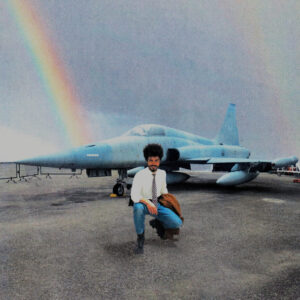By Ben Boddez
The Halifax pop-rocker embraces kindness as an act of rebellion, all while breaking musical and personal barriers.
When I video call Yves Jarvis, he’s somewhere in California, puttering around the house like you would when Facetiming a friend. He seems like the type of person that’s always in motion – to have released more than a dozen albums by age 25, you’d pretty much have to be. Talking to him now feels somewhat like pinning down a butterfly under a microscope. It’s like that when trying to describe his music, too. The surrealist musician’s kaleidoscopic sound, especially on his latest album The Zug, is hard to sum up. People try nonetheless – he’s been compared to everyone from Beck to D’Angelo, and anywhere in between. “I feel like you could literally compare me to anybody,” says Jarvis. “That’s the way I think about music, anyway.”
If there’s one thread to be traced throughout his wide-ranging discography, it’s the influence of fellow Albertan Joni Mitchell. Jarvis says he’s long admired her “no stone left unturned” approach to songwriting. But the best comparisons, in his opinion, are the ones he’s never heard of. His favourite example of this is when someone told him that his song “Bootstrap Jubilee,” a single off The Zug, sounded like Ween. “I had never heard Ween before, and I became obsessed,” says Jarvis. “It just reminds me that we’re all the same. We don’t have to have experienced something to have access to that experience.”
“Bootstrap Jubilee” also serves as an origin story. Born Jean-Sebastien Audet, Jarvis spent his early years in Montreal before moving to Calgary at age nine. He began messing around with music-making shortly after, around the age of 11. “Privileged upbringing/with two loving parents/educated and they nurtured my talents,” he sings. He began busking to save up for an iPod Touch, and the rest is history. Coming up in projects like Faux Fur and the You are Minez, you might also recognize him as Un Blonde, the now-retired moniker under which he released the Polaris-nominated Good Will Come to You. That venture, and now Yves Jarvis, are solo projects – almost religiously so.
Despite an early and prolific start in music, it doesn’t feel like Jarvis is on some sort of frantic grind. He speaks in a meditative candor, taking his time to chew on questions. I ask him what this album might taste like, and he lands on a cheese board. “With some fruit on there, like citrus? Maybe it’s something to do with maturity, something about balance.” He’s walked through pretty much every room in the house at this point. He rolls a joint and walks out to sit on the porch. “Maybe a dry aged steak,” he adds.
 This seems about right. The Zug finds Jarvis funkier and bolder than ever before. Even the tripped out retro leaning visuals of the album feel that way. Where the last couple of his albums conjured a single colour, The Zug feels iridescent. If his previous album, Sundry Rock Song Stock, was his green album – this is his rainbow album. There’s even a rainbow peeking out of the back of the grainy album cover where Jarvis is seen kneeling in front of an airplane.
This seems about right. The Zug finds Jarvis funkier and bolder than ever before. Even the tripped out retro leaning visuals of the album feel that way. Where the last couple of his albums conjured a single colour, The Zug feels iridescent. If his previous album, Sundry Rock Song Stock, was his green album – this is his rainbow album. There’s even a rainbow peeking out of the back of the grainy album cover where Jarvis is seen kneeling in front of an airplane.
His press photos conjure the same fuzzy 70s feeling. Jarvis toys with domesticity, holding a baking sheet in one and ironing a shirt in the other, both with a big grin. He wanted the Bob Ross-esque photos to stick out on your Spotify page. The Zug sees a serious artist playing with humour for perhaps the first time. “A breakthrough on this record was embracing humour, because humour is such a huge part of my life. And then it was like, ‘What the hell is it not doing in my work?’” Jarvis says.
Where his last album was made in the depths of nature, The Zug came out of a cramped Toronto condo. The sometimes frenetic, often hymn-like album feels a world away from where it was conceived. Jarvis found inspiration in unexpected places – like the clothing store across from his place, 100% Silk. “The caliber of textiles was just very inspiring. I was going in there every day and was very inspired by the material in a tactile way,” says Jarvis. “God, I drained my whole savings there.”
Another experience seeped into the album from that corner of Queen West. He was living on the top floor the day a jet show came to town, swooping close. This inspired the jet you’ll find on the cover of The Zug. “They were so low,” Jarvis says. “It amazed me that we have innovated to that degree, that we’re even flying at all. That things can be so powerful in their magnitude and control; that’s a big part of the record, for sure.
“I want the music to be like an aircraft,” Jarvis concludes. “I want it to be just absolutely blasting off, sheer power.”
By Ben Boddez
The Halifax pop-rocker embraces kindness as an act of rebellion, all while breaking musical and personal barriers.
By Kyla Pearson
With a new EP, a fresh sound, and lessons in self-love, the singer-songwriter embraces a bold new chapter.
By Sophie Bouquillon
South London’s genre-smashing alt-punk act tore through Toronto with snarling energy.